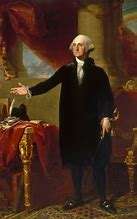deepundergroundpoetry.com

Save George Washington’s Portrait
The Under-told Story of Paul Jennings, an Enslaved Man Who Helped Save George Washington’s Portrait
During the War of 1812, British troops intended to ransack the American capital. The First Lady took credit for saving White House valuables, but, as Jennings wrote in his memoir, this was “totally false.”
POPULAR
The Under-told Story of Paul Jennings, an Enslaved Man Who Helped Save George Washington’s Portrait
Historical Painting Is Altered to Show Most Declaration of Independence Signatories Were Enslavers
Artists Quarantine With Their Art Collections
Required Reading
A John Lewis Documentary Probes Tensions Between National and State Power
SPONSORED
Gilbert Stuart, “George Washington” (1797), oil on canvas, 95 x 59.8 inches (image via Wikimedia Commons)
In the United States and Europe, offensive historic monuments are now being taken down as an extension of worldwide protests against racial inequality. From a toppled statue of 17th-century slave trader Edward Colston in England to various Confederate monuments across the United States (of which there are 1,712), and decapitated likenesses of Christopher Columbus, protesters and local authorities are rejecting symbols that normalize oppression.
Meanwhile, in the White House, a large-scale Gilbert Stuart portrait of George Washington hangs untouched. Two centuries ago, while Paul Jennings was the enslaved footman to fourth US President James Madison, he was ordered to help preserve this painting of the national patriarch — who held between 250 to 300 enslaved individuals. Sometimes, on top of the other miseries of bondage, oppression has included being forced to uphold monuments to one’s oppressor — ensuring that they survive to amplify one version of history while minimizing others.
This incident occurred on August 24, 1814, as British troops were nearing Washington DC during the War of 1812, intending to ransack the American capital. President Madison had already left the city, but First Lady Dolly Madison stayed behind and tried to rescue some valuables. She grabbed documents, velvet draperies, and the china set she’d selected for the dining room. Then it occurred to her to salvage the stately eight-foot portrait of Washington bolted to the dining room wall (and the first artwork purchased for display at the White House). She ordered a teenaged Jennings, gardener Thomas McGaw, and the French cook, John Syosset, to take it down.
A mural by William Woodward at the Montpelier visitor center in Orange, Virginia depicting the removal of the George Washington portrait from the White House in 1814 (image courtesy James Madison’s Montpelier)
And later, Madison took most of the credit for this laborious task herself. “She saw herself as saving the painting by giving orders to others,” writes Hilarie Hicks, the senior research historian at Madison’s former plantation, Montpelier. “But stories soon circulated, crediting Dolly with personally cutting the portrait from the frame with a carving knife.” The First Lady evidently wasn’t eager to correct these versions that inflated her contribution.
“It has often been stated in print, that when Mrs. Madison escaped from the White House, she cut out from the frame the large portrait of Washington (now in one of the parlors there), and carried it off. This is totally false,” Jennings later rectified the record in his short book, A Colored Man’s Reminiscences of James Madison (1865), which is considered the first White House memoir. “She had no time for doing it. It would have required a ladder to get it down. All she carried off was the silver in her reticule.”
Gilbert Stuart, Detail from “George Washington” (1797), oil on canvas (image via Wikimedia Commons)
(Incidentally, this prized portrait of Washington isn’t the original. It is a replica painted by Gilbert Stuart, but nonetheless a copy of his “Lansdowne Portrait” (1796), now at the National Portrait Gallery. The spine of one of the books on Washington’s desk intentionally misspells The Constitution and Laws of the United Sates to differentiate the original from later versions.)
It’s highly unlikely that Jennings, McGaw, and Syosset then had time to salvage any personally meaningful items before the British commandeered the mansion. But thanks to their labor, Washington’s painted likeness survived, and was eventually reinstalled in a White House rebuilt using slave labor. It now hangs in the East Room, a salon used for hosting dignitaries and special ceremonies.
Paul Jennings (photo courtesy the Sylvia Jennings Alexander Estate/ the Montpelier Foundation)
On August 24, 2009 — the 195th anniversary of the day Paul Jennings helped rescue this painting — a group of his descendants went on a special tour that included a visit to the East Room. President Barack Obama had begun his first presidential term earlier that year. The tour was arranged by Elizabeth Downing Taylor, who authored a biography of Jennings, A Slave in the White House: Paul Jennings and the Madison's (2013).
Some of the participants in this Jennings family reunion had long-known the story of the Washington portrait. “The Jennings family is extremely unusual in having such a well-documented enslaved ancestor and a story that’s been passed down through the generations,” Elizabeth Chew, executive vice president and chief curator at Montpelier, told Hyperallergic. “The Jennings descendants absolutely knew [about the portrait] because his children and grandchildren and so on preserved the story and passed it down.”
But not everyone in the group had been raised with knowledge of this particular event. “We knew about Paul Jennings,” shared Margaret H. Jordan, Jennings’s great-great-great granddaughter, who is also a healthcare executive and vice chairman of the Montpelier Foundation Board of Directors. “When I grew up, the Black community didn’t talk a lot about slaves and their history. We knew about it, we’re proud of the individuals, but we didn’t have long dialogues about their lives and what they did or didn’t do.”
“We were going through so much racism and disparity, so we spent a lot of time not getting into the fact that we had this deep heritage around slavery,” Jordan added. “It changed over time, it changed in my lifetime, and it changed around a lot of the things that happened in the ’60s. But early on growing up it wasn’t something that you walked around and talked about, that your grandfather was a slave.”
All the while, a monumental portrait of a problematic figure such as Washington remained installed in a place of honor in the White House.
The painting and the iconic building in which it stands would not be here without the labor of enslaved individuals — Paul Jennings being one of many, most of whose names are now lost. And yet, this image and the White House are monuments so embedded in the American historical narrative that they seem unlikely to be toppled, beheaded, or otherwise marred.
“When I return to Washington, the city where I was born and raised, I see places others do not,” Jordan wrote in a 2017 Washington Post op-ed about the incomplete and inaccurate ways that American history is taught. There are no plaques, markers, or monuments to Jennings or any of his descendants in Washington DC, even though the family’s history is intertwined with the American capital.
“Most Americans have not been taught to see and embrace African American history as part of their history as Americans,” Jordan wrote. “Indeed, in the telling of American history, we have failed to fully grapple with the reality of slavery and its lasting hold on society. This has consequences.”
All writing remains the property of the author. Don't use it for any purpose without their permission.
likes 1
reading list entries 0
comments 5
reads 290
Commenting Preference:
The author is looking for friendly feedback.







